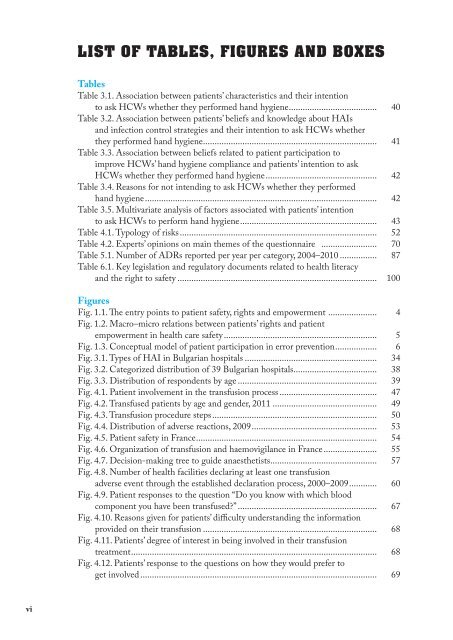Exploring patient participation in reducing health-care-related safety risks
Exploring patient participation in reducing health-care-related safety risks
Exploring patient participation in reducing health-care-related safety risks
You also want an ePaper? Increase the reach of your titles
YUMPU automatically turns print PDFs into web optimized ePapers that Google loves.
vi<br />
LIST OF TABLES, FIGURES AND BOXES<br />
Tables<br />
Table 3.1. Association between <strong>patient</strong>s’ characteristics and their <strong>in</strong>tention<br />
to ask HCWs whether they performed hand hygiene ...................................... 40<br />
Table 3.2. Association between <strong>patient</strong>s’ beliefs and knowledge about HAIs<br />
and <strong>in</strong>fection control strategies and their <strong>in</strong>tention to ask HCWs whether<br />
they performed hand hygiene ........................................................................... 41<br />
Table 3.3. Association between beliefs <strong>related</strong> to <strong>patient</strong> <strong>participation</strong> to<br />
improve HCWs’ hand hygiene compliance and <strong>patient</strong>s’ <strong>in</strong>tention to ask<br />
HCWs whether they performed hand hygiene ................................................ 42<br />
Table 3.4. Reasons for not <strong>in</strong>tend<strong>in</strong>g to ask HCWs whether they performed<br />
hand hygiene .................................................................................................... 42<br />
Table 3.5. Multivariate analysis of factors associated with <strong>patient</strong>s’ <strong>in</strong>tention<br />
to ask HCWs to perform hand hygiene ........................................................... 43<br />
Table 4.1. Typology of <strong>risks</strong> ..................................................................................... 52<br />
Table 4.2. Experts’ op<strong>in</strong>ions on ma<strong>in</strong> themes of the questionnaire ........................ 70<br />
Table 5.1. Number of ADRs reported per year per category, 2004–2010 ................ 87<br />
Table 6.1. Key legislation and regulatory documents <strong>related</strong> to <strong>health</strong> literacy<br />
and the right to <strong>safety</strong> ...................................................................................... 100<br />
Figures<br />
Fig. 1.1. The entry po<strong>in</strong>ts to <strong>patient</strong> <strong>safety</strong>, rights and empowerment ..................... 4<br />
Fig. 1.2. Macro–micro relations between <strong>patient</strong>s’ rights and <strong>patient</strong><br />
empowerment <strong>in</strong> <strong>health</strong> <strong>care</strong> <strong>safety</strong> .................................................................. 5<br />
Fig. 1.3. Conceptual model of <strong>patient</strong> <strong>participation</strong> <strong>in</strong> error prevention .................. 6<br />
Fig. 3.1. Types of HAI <strong>in</strong> Bulgarian hospitals ......................................................... 34<br />
Fig. 3.2. Categorized distribution of 39 Bulgarian hospitals.................................... 38<br />
Fig. 3.3. Distribution of respondents by age ............................................................ 39<br />
Fig. 4.1. Patient <strong>in</strong>volvement <strong>in</strong> the transfusion process .......................................... 47<br />
Fig. 4.2. Transfused <strong>patient</strong>s by age and gender, 2011 ............................................. 49<br />
Fig. 4.3. Transfusion procedure steps ....................................................................... 50<br />
Fig. 4.4. Distribution of adverse reactions, 2009 ...................................................... 53<br />
Fig. 4.5. Patient <strong>safety</strong> <strong>in</strong> France .............................................................................. 54<br />
Fig. 4.6. Organization of transfusion and haemovigilance <strong>in</strong> France ....................... 55<br />
Fig. 4.7. Decision-mak<strong>in</strong>g tree to guide anaesthetists .............................................. 57<br />
Fig. 4.8. Number of <strong>health</strong> facilities declar<strong>in</strong>g at least one transfusion<br />
adverse event through the established declaration process, 2000–2009 ............ 60<br />
Fig. 4.9. Patient responses to the question “Do you know with which blood<br />
component you have been transfused?” ............................................................ 67<br />
Fig. 4.10. Reasons given for <strong>patient</strong>s’ difficulty understand<strong>in</strong>g the <strong>in</strong>formation<br />
provided on their transfusion ........................................................................... 68<br />
Fig. 4.11. Patients’ degree of <strong>in</strong>terest <strong>in</strong> be<strong>in</strong>g <strong>in</strong>volved <strong>in</strong> their transfusion<br />
treatment .......................................................................................................... 68<br />
Fig. 4.12. Patients’ response to the questions on how they would prefer to<br />
get <strong>in</strong>volved ...................................................................................................... 69



